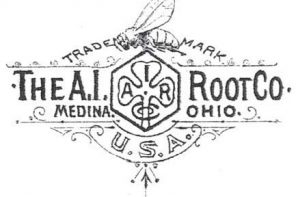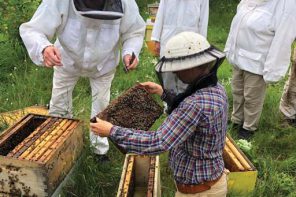By: Kim Flottum
The weather won this Spring. For the first time in – I guess nearly 50 years – I didn’t have some kind of garden out back. There’s been years when that out-back garden was only a couple of tomatoes stuck in the ground or in a pot next to the back step just out of reach of the dog chain. That’s the least out-back garden I’ve had, and, there have been a lot years when it wasn’t much more. That inch by inch itch just doesn’t go away. But for the last 30 some years though there’s been a 40’ x 40’ plot in back that has been slowly improving in terms of organic matter, drainage, fertility and production.
It’s lake bottom clay, but for the regular stuff – tomatoes, peppers, vine crops of all kinds along with cabbage, broccoli, and the leafy stuff it’s pretty good. Kale did fantastic the one year we tried it and the chickens feasted all Summer on that stuff. Lettuces of every kind and color always do well, and all kinds of peas and beans that have a special place on the far side with a permanent climbing fence all their own. And of course every year we try something new or different that works, or doesn’t, but is always fun no matter what. And when it doesn’t work the chickens get the leftovers.
We do the compost thing, kind of, right next to the asparagus which is right next to the garden and the blackberries. It’s three side-by-side sections are made from pallets. Each section is a pallet’s tall-side wide and two deep, with a middle section made from shared walls to keep posts and pallets to a minimum. All told, it cost me about $20 for posts and ties to hold the pallets to the posts. Pallets, if you look, are usually free for the taking if you’re not fussy about a missing board or two, so you take 15 when you need 10 and fix those with missing parts. A bit of labor, but I keep bees – who’s counting.
So there’s compost in all three sections most of the Summer. One gets filled, then the next, then the last, and then, if time and energy permit the first one gets turned before more is added. That happens sometimes. And sometimes not (see labor, above). Most of what gets added is the chicken coop floor clean-up from overwinter and Summer coop stuff as time and mess dictate. Mostly straw, chicken manure and spilled chicken feed, it takes care of itself with the usual amount of rain and the other stuff that gets added on top during the Summer. A section full of whatever, top to bottom front to back, gets reduced to about a foot-high pile of really good compost to add to the garden by next spring.
Any weeds that get pulled in the garden, yard edge or flower beds get a one way trip to the chickens who relish the green stuff. Pretty much all summer the lawn doesn’t get mowed nearly as often as the neighbors, so chickens get the piles of cut grass that’s raked up so what’s left doesn’t get covered. They get all the out of place purple loosestrife, wild grapes, or any of a thousand kinds of weeds that seem to flourish in our back acre when and if they get pulled. There’s a saying – I think I made it up, but probably not – chickens will eat almost anything, and almost everything eats chicken (hawks, coyotes, fox, skunks, neighbor dogs, owls, racoons, take your pick).
Anyway, back in early June I took a long weekend to do the garden thing. The rototiller was overhauled and ready, the seedlings I’d started way back in December and January were ready and so were the transplants I’d bought and nursed this long, all eager to get roots in the ground and get going. It rained two out of every three days in late May and June so I wasn’t surprised when the forecast predicted nine out of 11 days more rain the day I wanted to begin. And it rained, and rained.
I knew in would be at least, at least, two weeks before I could get the rototiller into the garden after it finally quit and by then it would be pushing the first day of Summer. And another piece of this is that I’m gone, a lot, so whatever rain-free windows there were got lost. The weather won round one.
Choices. Like anything else in life, you have choices. With bees, you can combine weak colonies so one strong colony thrives, or you can requeen the weak one and hope. You can feed early so they take advantage of that early flow, or you can measure and treat and measure again and treat again to keep Varroa near zero and make splits all Summer ignoring the honey and sell bees all Summer. Obviously you can ignore mites completely and hope. Or you can overwinter those nucs and make Spring splits for more bees and even more money. Of course you can use Russians if you start late or Carniolans if you start early, and you can move those bees to honey or pollination sites for money or you can stay home all year if it’s safe. And now you can use at least a dozen different kinds of hives for your bees that fit you, no matter what the bees think. Those hives can be wood or plastic or poly or thick or thin wall or top bar or warre or long or eight frame or 10 frame or deeps or mediums or mixed. You can harvest honey early and often for all manner of different varietals, or you can let it sit for a while and then harvest Summer honey later and then harvest Fall honey even later or just let it sit all Summer and make – ugh – wildflower honey. And anytime you can blend for color or flavor or make mead. Of course that honey can be liquid, comb, cut comb, chunk or creamed and you can sell it in any size or kind of container you want from home or at work or at the local farm market or grocery store or you can put it in a pail or barrel and sell it to the highest bidder. Choices, there’s always lots of choices.
So, I had a three day weekend to make that garden choice. Wait, or . . .?
Well, if not in the regular garden, where? Not many choices but pots on the deck won. I have a pretty big deck, lots of pots, and potting mix and fertilizer is cheap in the spring. I’ve raised all manner of garden stuff on the deck over the years by choice so this wasn’t new. Just more. Forty some pepper plants, 30 some tomatoes, and a few, actually far fewer other choices – vines, beans, peas.
It’s July holiday weekend now, and all of the above are doing well. I’ve learned – though you don’t get quite as much no matter how green your thumb is, but there’s always munchables when you walk out there, and more than enough for supper and to give away (I love growing hot, hot peppers because they are a truly a pretty plant, but I’ll never eat one – food shouldn’t hurt you know), and I can put together a basket of a dozen different tomatoes for folks at work and neighbors who don’t get the garden itch anymore, but still love the home-grown flavors of our produce.
But the one choice I couldn’t make this year became completely obvious almost instantly. A raised bed garden. Duh. It had never been something to consider but suddenly it was the only thing to consider. I have lawn adjacent to the deck that’s only a step away (read no muddy paths), easy to work (you can reach everything without much of a stretch), easy to manage (no hose to drag and sprinklers to water), easy to expand and just plain easy, no matter the weather, ever. And, when all is said and done, retiring the rototiller, the shovel, the sprinkler system, the drainage system, the mulching and weeding and all the rest won’t be too much to let go (sorry chickens). The compost is close and easy to keep using. And you can grow anything you want in the right raised bed garden with the right soil and exposure. And I have soil and exposure and fertilizer down to a science. Too often the best choice doesn’t come along until all the rest don’t work.
The weather won round one this year. But I got the last word though because I’m still getting some tomatoes and peppers. There are always choices. But you know, don’t overlook the one that’s the best one, even if it’s the last one.
That weather won a lot of other matches this Spring too. Planting corn and soybeans didn’t happen in a lot of places for the same reason my garden didn’t get in. But even so, farmers had some choices. One of those was, instead of the regular crop that couldn’t get in, later planting of cover crops was an option. What an opportunity that could have been, right? Can you imagine instead of something like 90+ million acres of corn and nearly that much soy, there could have been some millions of acres of cover crops like turnips, radishes, crimson or berseem clover, field peas or a vetch crop? Even mustard crops, buckwheat or brassicas? Let go to bloom but not mature to seed, these crops would have done farmers a world of good for soil help, weed control, helped with some of the USDA regs on crop insurance and trade assistance acres for prevent plant options, and think of your bees next to a county’s worth of clover or vetch!
Some farmers made that work, but most were caught by surprise as were the seed companies and not nearly enough of what we would have liked got planted. Rather, grasses, forages, crops for silage, haylage and baleage made the cut because there was some of that seed and a farmer could plant them, and harvest for winter food after September 1, rather than after November 1 as usual when considering a cover crop for animal feed.
Choices. The best one was the first one, but it didn’t, mostly, get a chance.
More Choices. This is a blatant commercial for two things. First, the KIM&JIM Show, with Jim Tew, me, and usually other fine folks. The next to last one we did as I write this Jim was in France talking to the Veto Pharma folks about what they do relative to medications and testing equipment for varroa and looking at their extracting facility. The next show was where we worked bees at the A.I. Root Homestead, looking at the packages we put in this Spring and then sitting on A.I.’s front porch talking about all the fine folks over the past 150 or so years that have sat in the same place talking about – what else, bees, beekeeping and beekeepers. It was sort of one of those moments you don’t get to do very often. Next, if it worked, by now, we’ll have traveled to Jim’s beeyard, looking at his repaired fence, the new development going up right next door and what that’s going to mean for his bees, liability and more – and we don’t exactly know what more that is going to be. Check it out.
BEEKEEPINGTODAYPODCAST.COM has some new interviews going for it too. Movie people, all the Pollinator Week folks we talked to, and Brad Root talking about the second 50 year history of the Root Company. And, more I’m sure since there’s a three plus week delay between this and when you get it in the mail – so, Surprise! Take a look at our podcast series. Never a dull moment.
Choices. There’s always lots of choices.
Always lots of choices, except sometimes.
One of the farm magazines we get here had an article on Veterinarians recently. With the change in obtaining antibiotics for controlling foulbrood that recently went into effect, beekeepers now have to think about the local vet. And local vets are fewer and farther between than ever, in case you haven’t noticed.
A few highlights from the article, by Betsy Freese, Exec. Editor of Successful Farming. She interviewed 21 vets in 13 states.
- There are about 500 counties in the U.S. underserved by a vet in 2019, mostly rural and there are shortages in 44 states.
- Large animal vets have a lot of job offers, but the pay isn’t close to that of vets in metropolitan areas, and rural vets are on call something like 180 days a year, 24-7.
- The largest employer of vets in the world is a candy company. Mars Candies owns more than 2,000 vet hospitals in the U.S. and Europe with over 50,000 employees.
- Of the over 30,000 vet practices in the U.S., about 3,500 are corporate-owned.
- More than 60% of the 110,000 vets in the U.S. are women
- Vet schools now are 80-90% women students
- 2018 graduates from U.S. Vet colleges averaged $143,000 in debt
- Scholarships, grants and loans are increasing to help with debt, but there are strings attached on getting a job after school
- Only 10% of final year students have an interest in food animal medicine at graduation
- Rural mixed animal vets are the most in demand, and are being replaced by nonveterinarians working for non-profits with products to sell direct to farmers
- Basically, vets are undervalued
- Who is going to sign up for a career of cutting a cow open a 2 a.m. with compensation lower than what a plumber makes?
Choices. Often they aren’t easy. Or even possible.







